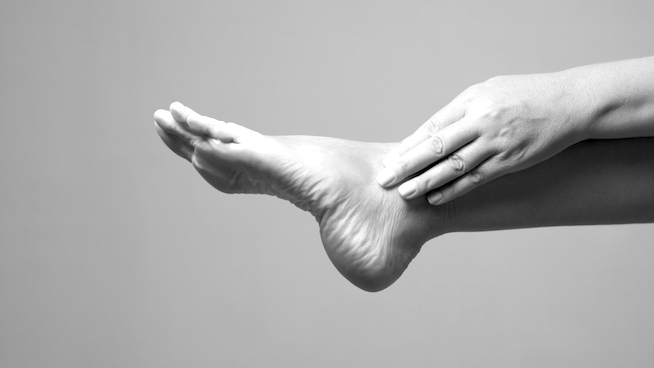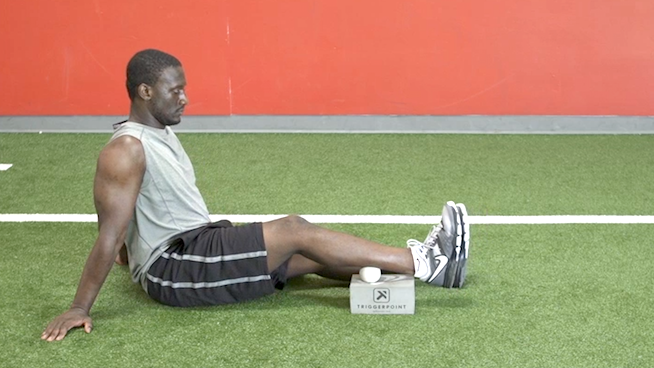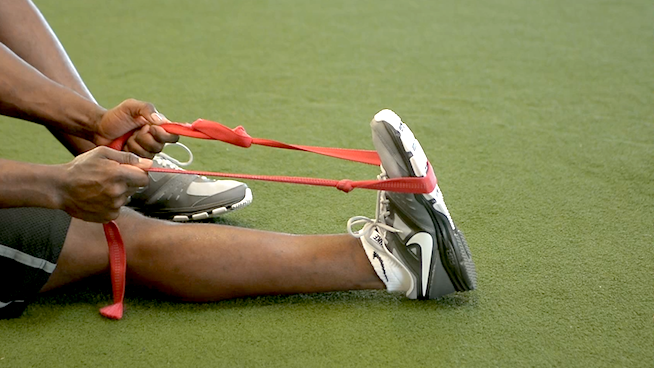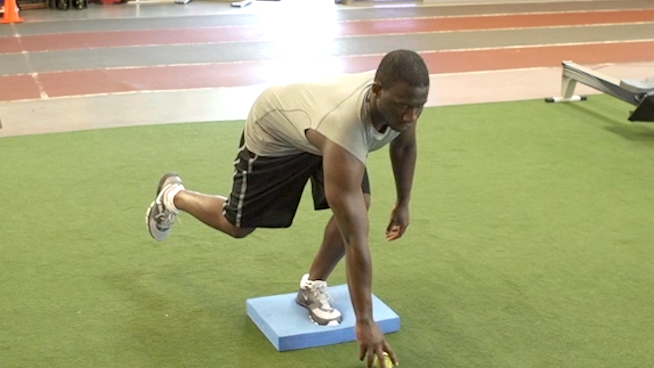Why Ankle Mobility Training is a Must
Of all the parts of your body to worry about, your ankles are probably low on the list. Tight hamstrings, back pain and other issues typically take precedence. Ankles aren’t that important, right?
Wrong. It’s time to change your mindset. Poor ankle mobility—specifically in dorsiflexion, the ability to bring your foot toward your shin—can cause exercise form errors and increase your risk of injury when playing your sport.
We spoke to Brandon McGill, sports performance director for STACK Sports Performance, to learn more about this commonly overlooked joint.
Why Ankle Mobility Is Important

To understand the importance of ankle mobility, we need to take a step back and look at the body joint-by-joint. From the ground up, at a basic level, the body is an alternating stack of stable and mobile joints. Lowest to the ground are the ankle joints (mobile), followed by the knee joints(stable), followed by the hips (mobile), then the lower back (stable) and so on. Limited ankle mobility directly affects how well the other joints function.
RELATED: 4 Hip Flexor Stretches to Relieve Tight Hips
“If you don’t have the ankle mobility to perform a lift, your body is going to automatically compensate and find it somewhere else,” McGill explains. “That’s one of the wonders of our bodies, but it’s one of the biggest problems for athletes. Eventually something might not be able to take the load you’re putting on it.”
A common example of an ankle mobility problem presents itself in the Squat. If you have tight ankles, it will be difficult for you to squat to parallel without your lower back rounding (referred to as butt wink). Many other things can limit squat depth, but ankle mobility is always a prime suspect.
Even if you know proper exercise form and attempt to perform it correctly—as you always should—tight ankles might make it impossible. Result? an increased risk of injury to another part of your body.
There is a chain-reaction effect, and if your ankles can’t move through a full range of motion, you are especially at risk when you play your sport—almost like a muscle group would be at high risk for injury if it lacked flexibility.
“The ankle is one of the joints that’s at the highest risk of injury, especially in sports where athletes are doing a lot of single-leg cutting and change of direction,” McGill says. “That extra mobility is going to give you a cushion against getting hurt if you have to take an extreme cut that wasn’t planned. We see this all the time in soccer, basketball and sports where you’re trying to evade an opponent and you have to take a big step.”
McGill sums it up: “If the ankle isn’t doing its job, there’s a much higher risk of injury.”
RELATED: The No. 1 Cause of Hamstring Injuries
How to Test Ankle Mobility
To find out if you have sufficient ankle mobility, perform the Half-Kneeling Dorsiflexion Test:
- Kneel on one knee with your front foot exactly 5 inches from a wall. Ideally, you should be barefoot.
- Place your hands on the wall in front of you.
- Lean forward and attempt to touch your front knee to the wall without lifting your heel off the ground.
- If you can touch the wall, you can be confident you have sufficient ankle mobility.
How to Improve Ankle Mobility
According to McGill, ankle mobility is fairly difficult to improve. You can’t just do a few stretches and miraculously expect to fix your balky ankles. Instead, he recommends a comprehensive approach using the Ankle Reset Series below, which includes a myofascial release exercise (i.e., foam rolling) to improve tissue quality, a static stretch and another movement that reinforces optimal range of motion.
Whether you have excellent ankle mobility or need work, it’s important to maintain ankle joint health. If you passed the mobility test above, perform the Ankle Reset Series once per week after a workout. If you failed the test, do it twice per week.
Lax Ball Calf

This is similar to foam rolling in that it helps to improve tissue quality by eliminating trigger points and realigning muscle fibers in your calf so the muscles will be able to contract and relax with maximum length and force.
Sets/Duration: 1×2 min. each side (focus on tender areas)
Strap Ankle Stretch

This static stretch increases flexibility in the calves, which increases range of motion in the ankles. Performing it after the Lax Ball Calf makes the stretch more effective because the muscle is primed to lengthen.
Sets/Duration: 1×1 min. each side
Single-Leg Reach and Grab

The final exercise in the series teaches your nervous system to recognize the new range of motion that you created in the first two exercises for a lasting effect.
Sets/Reps: 1×10 each side
RECOMMENDED FOR YOU
MOST POPULAR
Why Ankle Mobility Training is a Must
Of all the parts of your body to worry about, your ankles are probably low on the list. Tight hamstrings, back pain and other issues typically take precedence. Ankles aren’t that important, right?
Wrong. It’s time to change your mindset. Poor ankle mobility—specifically in dorsiflexion, the ability to bring your foot toward your shin—can cause exercise form errors and increase your risk of injury when playing your sport.
We spoke to Brandon McGill, sports performance director for STACK Sports Performance, to learn more about this commonly overlooked joint.
Why Ankle Mobility Is Important

To understand the importance of ankle mobility, we need to take a step back and look at the body joint-by-joint. From the ground up, at a basic level, the body is an alternating stack of stable and mobile joints. Lowest to the ground are the ankle joints (mobile), followed by the knee joints(stable), followed by the hips (mobile), then the lower back (stable) and so on. Limited ankle mobility directly affects how well the other joints function.
RELATED: 4 Hip Flexor Stretches to Relieve Tight Hips
“If you don’t have the ankle mobility to perform a lift, your body is going to automatically compensate and find it somewhere else,” McGill explains. “That’s one of the wonders of our bodies, but it’s one of the biggest problems for athletes. Eventually something might not be able to take the load you’re putting on it.”
A common example of an ankle mobility problem presents itself in the Squat. If you have tight ankles, it will be difficult for you to squat to parallel without your lower back rounding (referred to as butt wink). Many other things can limit squat depth, but ankle mobility is always a prime suspect.
Even if you know proper exercise form and attempt to perform it correctly—as you always should—tight ankles might make it impossible. Result? an increased risk of injury to another part of your body.
There is a chain-reaction effect, and if your ankles can’t move through a full range of motion, you are especially at risk when you play your sport—almost like a muscle group would be at high risk for injury if it lacked flexibility.
“The ankle is one of the joints that’s at the highest risk of injury, especially in sports where athletes are doing a lot of single-leg cutting and change of direction,” McGill says. “That extra mobility is going to give you a cushion against getting hurt if you have to take an extreme cut that wasn’t planned. We see this all the time in soccer, basketball and sports where you’re trying to evade an opponent and you have to take a big step.”
McGill sums it up: “If the ankle isn’t doing its job, there’s a much higher risk of injury.”
RELATED: The No. 1 Cause of Hamstring Injuries
How to Test Ankle Mobility
To find out if you have sufficient ankle mobility, perform the Half-Kneeling Dorsiflexion Test:
- Kneel on one knee with your front foot exactly 5 inches from a wall. Ideally, you should be barefoot.
- Place your hands on the wall in front of you.
- Lean forward and attempt to touch your front knee to the wall without lifting your heel off the ground.
- If you can touch the wall, you can be confident you have sufficient ankle mobility.
How to Improve Ankle Mobility
According to McGill, ankle mobility is fairly difficult to improve. You can’t just do a few stretches and miraculously expect to fix your balky ankles. Instead, he recommends a comprehensive approach using the Ankle Reset Series below, which includes a myofascial release exercise (i.e., foam rolling) to improve tissue quality, a static stretch and another movement that reinforces optimal range of motion.
Whether you have excellent ankle mobility or need work, it’s important to maintain ankle joint health. If you passed the mobility test above, perform the Ankle Reset Series once per week after a workout. If you failed the test, do it twice per week.
Lax Ball Calf

This is similar to foam rolling in that it helps to improve tissue quality by eliminating trigger points and realigning muscle fibers in your calf so the muscles will be able to contract and relax with maximum length and force.
Sets/Duration: 1×2 min. each side (focus on tender areas)
Strap Ankle Stretch

This static stretch increases flexibility in the calves, which increases range of motion in the ankles. Performing it after the Lax Ball Calf makes the stretch more effective because the muscle is primed to lengthen.
Sets/Duration: 1×1 min. each side
Single-Leg Reach and Grab

The final exercise in the series teaches your nervous system to recognize the new range of motion that you created in the first two exercises for a lasting effect.
Sets/Reps: 1×10 each side










